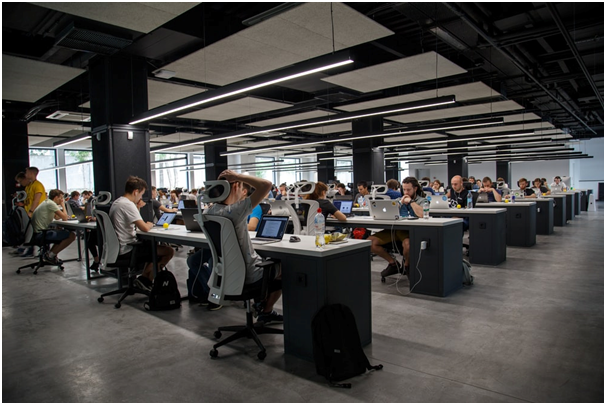
A New World of Work
Companies are transforming offices and amending workplace policies based on the changing behaviour of employees towards work.
As companies were gearing up to call their employees back to the office in 2022, the world discovered the Omicron variant. Businesses had to take a step back and re-evaluate their options. Such events best describe the uncertainties corporates have faced since the pandemic started and are being used as big learning for the future.
It all started with workplaces going completely virtual within a few days of the outbreak in 2020, as the government imposed a nationwide lockdown. When restrictions were localised, businesses had to deal with supply-chain disruptions and focus on the well-being and safety of employees, some of whom had to be back at work.
As employees adopted the new way of working, organisations discovered that the traditional office setup could turn obsolete. Companies began experimenting and evaluating newer work models. Some implemented hybrid work that allows employees to function part-time from the office. Others opted for going closer to employees' homes to minimise commute. Almost all corporates are redesigning their existing and future offices based on what they think will be the future of work.
As the pandemic keeps the situation fluid, one thing has emerged clearly that flexibility and agility will continue to shape the new world of work. What is certain is that based on the trends and developments of the past two years, a few changes are here to stay for the long term.
Employee preferences are top priority
Employee priorities towards work are now different, primarily because of lifestyle changes while working from home. According to JLL's global survey, which included Indian employees, the time saved in commuting is spent mainly with family, or on leisure activities, or taking care of oneself. The change in work pattern has made work-life balance the top priority for employees, in some instances, even ahead of compensation. In the same survey, 88% of employees said they wish to choose their working hours.
Companies, too, have started thinking about employees' preferences more than ever. Corporates have introduced a weekly 'self-care day' and mental health breaks to let employees deal with the anxiety that the pandemic has caused. Besides the hybrid work model, companies are also offering flexible working spaces (or flex). They have even established satellite offices in tier-2 and tier-3 cities that let employees work close to home and visit the office as and when they want.
The hybrid and flex work models are here to stay. Many companies were already exploring this model before the pandemic. The pandemic accelerated the implementation of these models. More businesses are going to establish satellite offices in metros and smaller cities. According to the JLL-Awfis survey, more companies are taking up office space in tier-2 cities as corporates want to enhance their presence there, given the business opportunity and the talent availability due the reverse migration that happened during the pandemic.
Office is no longer for routine work
Employees no longer want to work out of the office doing their routine work like coding, attending calls, answering emails, etc. The value an office brings now goes beyond accomplishing tasks and finishing projects. People want to socialise, engage, meet clients in person and collaborate with their co-workers when they are in the office.
Businesses are redesigning offices to be in sync with the changing workforce preferences. In a traditional office setup, desk and individual workspace occupied up to 70-80% of the area—around 20-30% was dedicated to collaborative work. The ratio is changing. Almost all companies are redesigning their offices with more collaborative and green spaces.
According to JLL's report on 'Regenerative Workspaces', workers' top three expectations include relaxation spaces, healthy food options, and outdoor and social spaces. Corporates are taking regular feedback into account when redesigning offices.
Focus on sustainability and rise of tech
Since the COVID-19 outbreak, the demand for sustainable offices has increased. More corporates are drawing up plans to achieve net-zero carbon emissions. Consequently, they not only want their office spaces to be green but are driving developers to avail green building ratings and certifications.
Employees, too, are mindful and demanding a focus on sustainability. According to a JLL Asia Pacific survey, 7 in 10 workers believe that sustainability initiatives are a must for businesses today, and companies should follow sustainable business practices.
Younger people are keener to work for environmentally and socially responsible corporates. Among the 21-30-year age group, 7 in 10 employees said they want to work for a sustainability leader. In the coming years, sustainable workplaces and practise could be one of the ways to retain and attract talent.
An office designed and operated based on green building concepts will, typically, have biophilic, more natural light, reduction in water wastage, no single-use plastic.
It's difficult to achieve a desired future workplace without using technology, which is likely to be the biggest catalyst for productive green progress. The technologies that are now available – and others in the process of being developed – are set to radically reshape how we construct, interact with and use spaces.
Overlap of Personal and Professional Lives
Traditionally, personal and professional lives have remained segregated. With work from anywhere, workcation, etc., these lines have blurred and merged at all levels to a large extent. It's not uncommon for children to come around and exchange greetings or pets to vie for attention during a work call.
Organisations and people are using such instances to improve relationships and productivity while being mindful of mental well-being and respecting boundaries. Overlapping personal and professional lives can help teams form better bonds and understand each other in everyday challenges.
As the pandemic takes its own uncertain course, professional and personal lives will increasingly overlap and continue to define the new world of work - more often for good.
Source: https://www.jll.co.in/en/trends-and-insights/workplace/a-new-world-of-work


